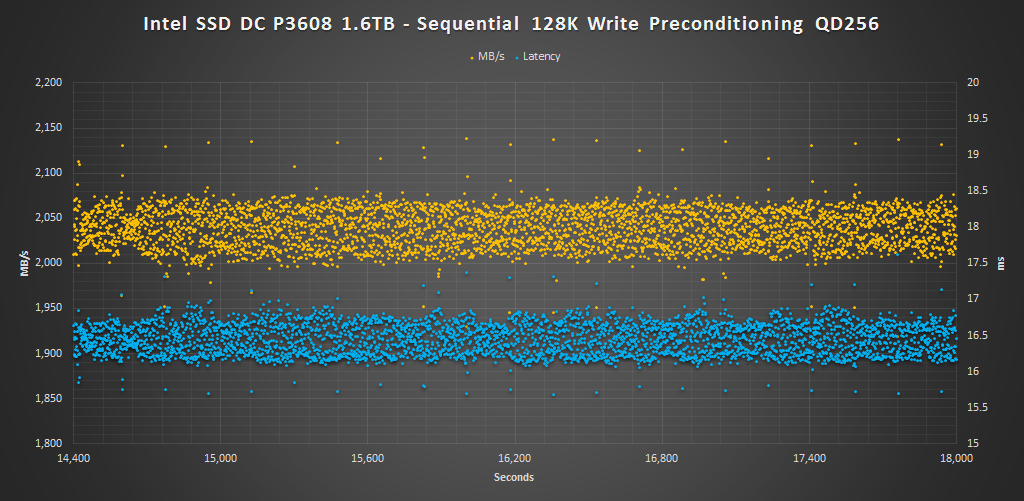128KB SEQUENTIAL READ/WRITE
Sequential performance is measured similarly to the other two tests before. The drive is first secure erased to get it in a clean state. Next, we precondition the drive with a 128KB sequential write workload at QD256 until the drive is in a steady state. Finally, we cycle through QD1-256 for 5 minutes each for writes and then reads. All this is scripted to run with no breaks in between. The last hour of preconditioning, the average MB/s, and average latency for each QD is graphed below.
Our 128KB sequential write preconditioning RAID 0 results are very promising. During the last hour it maintained performance over 2GB/s for the most part and averaged around 2,040MB/s overall. Latency at QD256 maintained between 16-17ms.
If you were impressed with its random performance before, look at this. The Intel SSD DC P3608 reached over 5GB/s! More specifically it was able to reach 5.3GB/s at QD64. After QD128 performance dropped off down to 4.87GB/s. The single volume was able to reach 2.3GB/s
Taking a look at RAID 0 latency, up to QD32 the latency is well below 1ms. At QD64 it averages 1.6ms and at QD128 it averages just over 3ms. It then doubles to 6.9ms at QD 256. The single volume shows about double across the board.
In RAID 0 performance quickly ramps up to 1.8GB/s write at QD 2 and peaks out at an average of 1.93GB/s at QD64 with latency that averages 4.3ms. Its QD256 results are interesting here because they don’t reflect the preconditioning results. After cycling through QDs performance is a bit lower with the average write speed of 1.9GB/s and latency now at just under 18ms rather than over 2GB/s and 16.5ms. Still, however, the results are good.
The single volume shows more consistent performance with QD1 write being about the same as the higher QDs. Latency is once again, about double RAID 0’s per QD.
 The SSD Review The Worlds Dedicated SSD Education and Review Resource |
The SSD Review The Worlds Dedicated SSD Education and Review Resource | 


Random adjectives, desperate efforts to “humanize” the tech resulted in this huge review to contain next to no information at all.
There is no easy way to say this: software RAID 0 on PCIe is simply retarded.
Thanks for your thoughts
Now just make it affordable
Well, for enterprise it is very affordable for what you get. If you are concerned about consumers/enthusiasts I can see where you are coming from, but this is not meant for them. Next year, however, we may be seeing performance like this trickle down.
More than likely next year
As an enterprise product I can see it as a high-end workstation device but not a server device. The lack of RAIDability seems to limit its use to caching and high-speed scratch work area.
I’ve been informed that PCIe hardware RAID will be available on the Skylake CPU and the Xeon version when it comes out later. Now we’re talking………
so this is a preview, not a review… where are the comparisons to P3700 and PM951?
I don’t have access to those drives. We reviewed the P3700 in another system. Because of that as well as a change in our testing methodology, we cant not graph them side by side. Looking at the P3700’s specific review you can gauge for yourself the approximate performance difference between the two.